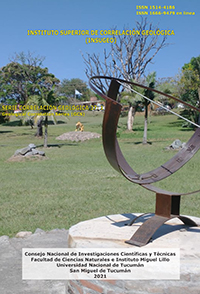Serie Correlación Geológica 37 (1)
Análisis granulométrico de sedimentos y dinámica fluvial en la cuenca del río Lorohuasi (Cafayate, Salta)
Daniela I. Quintero | Vanina L. López de Azarevich | Silvia E. Ferreira | Adriana E. Rovere | Patricia C. Espinoza | Carolina R. Sulbelza
Descargar trabajo en formato PDFResumen
Los procesos fluviales tienen la capacidad de modificar todos los sistemas terrestres. La liberación de componentes, su transporte y depositación como sedimentos por el agua, tienen consecuencias ambientales importantes, muchas de las cuales pueden ser deteriorantes o irreversibles. Las regiones áridas son susceptibles a la erosión hídrica, ya que la sola existencia de flujo ácueo es excepcional y la situación común es su extrema velocidad, que se conjuga con la variabilidad espacio-temporal del transporte de sedimentos. En este contexto, el objetivo fue analizar la dinámica en el transporte de sedimentos en la cuenca del río Lorohuasi, Cafayate, Salta, en los tramos medio de los tributarios Alisal y Colorado, en todo el río Lorohuasi y el sector de desembocadura con el río Santa María, entre los años 2016 y 2020. En 30 parcelas de 1 m2 ubicadas en 14 sitios de estudios, se recolectaron 30 muestras de sedimentos medianos y finos en el cauce activo de los ríos. En cada sitio se midió el ancho y pendiente del cauce, como así también el caudal; con los datos granulométricos de los sedimentos medianos se construyeron gráficos de frecuencia acumulada y tablas de parámetros estadísticos (media, mediana, moda, desviación estándar, asimetría y curtosis), a fin de caracterizar y analizar la distribución de las fracciones granulométricas a lo largo de los cursos fluviales, evaluar la dinámica de sedimentación y caracterizar el agente de transporte. Los resultados exponen que en general, la granulometría media de todo el material analizado transportado en la cuenca del río Lorohuasi es arena media (phi 1,15), con media-mediana-moda en la misma fracción, la distribución es mesocúrtica, simétrica y el material es pobremente seleccionado. El sedimento se transporta mayormente por saltación en los ríos Colorado y Alisal, y por saltación y/o suspensión en el río Lorohuasi. Se concluye que las características físicas de la cuenca y las actividades antrópicas influyen en la granulometría de los sedimentos analizados, especialmente en la cuenca baja, y que técnicas de rehabilitación en las riberas afectadas podrían devolver la funcionalidad de las mismas y proteger el sistema fluvial.
Abstract
GRANULOMETRIC ANALYSIS OF SEDIMENTS AND FLUVIAL DYNAMICS IN THE LOROHUASI RIVER BASIN (CAFAYATE, SALTA) River processes have the ability to modify all terrestrial systems. The release of components, their transport and deposition as sediments by water have important environmental consequences, many of which can be deteriorating or irreversible. Arid regions are susceptible to water erosion, since the mere existence of water flow is exceptional and the common situation is its extreme speed, which is combined with the spatio-temporal variability of sediment transport. In this context, the objective was to analyze the dynamics of sediment transport in the Lorohuasi river basin, Cafayate, Salta, in the middle sections of the Alisal and Colorado tributaries, throughout the Lorohuasi river and the river mouth in the Santa María river, between the years 2016 and 2020. In 30 plots of 1 m2 located in 14 study sites, 30 samples of medium and fine sediments were collected in the active channel of the rivers. At each site, the width and slope of the channel was measured, as well as the flow, with the granulometric data of the medium sediments, were constructed accumulated frequency graphs and tables of statistical parameters (mean, median, mode, standard deviation, asymmetry and kurtosis), in order to characterize and analyze the distribution of the granulometric fractions along the river courses, evaluate the sedimentation dynamics and characterize the transport agent. The results show that in general lines, the mean granulometry of all the analyzed material transported in the Lorohuasi river basin is mean sand (phi 1.15), with mean-median-mode in the same fraction, the distribution is mesokurtic, symmetric and the material is poorly selected. The sediment is transported majorly by saltation in the Colorado and Alisal rivers, and by saltation and/or suspension in the Lorohuasi river. It is concluded that the physical characteristics of the basin and anthropic activities influence the granulometry of the analyzed sediments, especially in the lower basin, and that rehabilitation techniques in affected riverbank areas could restore their functionality and protect the river system.






